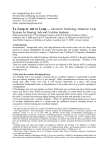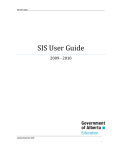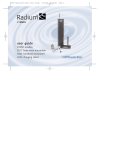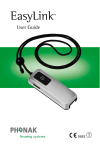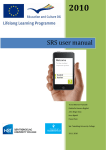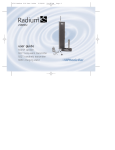Download FM TroubleShooting
Transcript
Phonak FM Systems: Preventative Maintenance and Trouble Shooting Guide Index 1. Morning checks Receivers 3. Frequently Asked Questions page MicroLink MLx MLxS ML8 ML8S ML9S EduLink 3 3 3 3 3 3 3 Transmitters Receivers MicroLink MLx MLxS ML8 ML8S ML9S EduLink Transmitters TX3 HandyMic Campus S SmartLink SX 3 3 3 TX3 HandyMic Campus S SmartLink SX 4. Contact Information 2. Detailed Trouble Shooting Receivers MicroLink MLx MLxS ML8 ML8S ML9S EduLink Other manufacturers 5 5 5 5 5 5 5 6-7 Transmitters TX3 HandyMic Campus S SmartLink SX page 10-11 10-11 10-11 10-11 10-11 10-11 10-11 8 8 9 EduLink 2 12-13 12-13 12-13 15 1. Morning Check Sheet Receivers Name: Right Left HA Switch Position: HA Switch Position: Audio Shoe: Audio Shoe: Default Frequency: Frequency Default: Serial Number: Serial Number: Questions Test Action Hearing instrument Transmitter expected expected outcome outcome Does hearing Listen to aid alone instrument work? Should be working Own voice should be amplified Does FM receiver mute hearing instrument microphone? Connect receiver and listen to FM only (single dot) with Transmitter turned off The hearing instrument Should hear a NA mic should be off buzz in the hearing instrument Does transmitter work on FM only? Turn on the transmitter Rub your finger over Environmental mic Mic should and leave the receiver the transmitter and should be inactive be active on FM only (single dot) hearing instrument mic NA Does transmitter Switch the receiver work on FM + M? to FM+M (two dots) Rub your finger over Should hear the transmitter and a response hearing instrument mic Should hear a response Final sound check Talk into both mics independently Should be clear and undistorted Should be clear and undistorted This sheet can be photocopied in order to keep a record of settings and daily checks for individual users. 3 Morning Checks Note If you are experiencing intermittent problems please check the following: • Check that the audio shoe is the correct model. This must be an MLx / MLxS shoe signified by a grey base. Check for a loose fit or damage to the electrical contacts. • Ensure the hearing instrument battery is new. A battery tester will not check under load so it may indicate a charged battery that will not operate the receiver. • Check transmitter microphone leads are secure and the volume of the hearing instrument is optimal. • Check that the earmolds are free from wax. • If you suspect that the transmitter is not working go to the transmitter Trouble Shooting section (Page 9). 4 2. Detailed Trouble Shooting Receivers MLx / MLxS Note Always check that the hearing instrument is functioning. If it is not, then the FM system will not work. • Does the hearing instrument have a new battery? • Is the direct audio input contact covered as they are delivered with a cover? Remove the cover if necessary. You should see 3 gold contacts. • Does the battery door have a hole in it? Some manufacturers hearing instruments do not have this as standard. The hole is necessary to power the receiver. • Has the FM programme been activated in the hearing instrument? • Is the hearing instrument program switch in the correct position? For details of audio shoe and switch positions see the enclosed guide or go to: http://www.phonak.co.uk/ccuk/professional/productsp_uk/fm/mlx.htm MLxS FM Activation Chart Hearing Instrument Audio Shoe AS5 - MLx Hearing Instrument Switch Position Middle dot Aero Automatic MAXX AS5 - MLx M Automatic Valeo AS5 - MLx Middle dot Automatic Supero AS4 - MLx / MLxS On FM or FM+M program Need to activate when programming Perseo ML8S (integrated receiver) On FM or FM+M program On FM programme Claro ML8S (integrated receiver) On FM or FM+M program On FM Programme Savia ML9S (integrated receiver) On FM or FM+M program On FM programme 5 FM Activation Detailed Trouble Shooting Note: EduLink FM Activation EduLink is an FM receiver only. To activate ensure that the receiver is turned on and that the default frequency matches the transmitter. MLxS Activation with other manufacturers hearing instruments Note MLx / MLxS is not compatible with all hearing instruments. Please ensure compatibility before purchase. Oticon • Check there is a hole in the battery draw. This is a necessary modification. • Does the hearing instrument have direct audio input contacts? This is not standard on all hearing instruments. • Check the hearing instrument is in the ‘M’ position. • Check with Oticon to ensure the hearing instrument does not need to be modified. This is dependent on serial number. Widex • All hearing instruments are compatible with MLx / MLxS. • Check the hearing instrument is in the ‘M’ position. • The programming socket and the MLxS contact may be the same. 6 Detailed Trouble Shooting GN Resound • • • • Hearing instruments are compatible without modification. The programming port and the MLxS activation may be the same. The FM needs to be activated during programming. The switches will behave differently on the MLx / MLxS. The hearing instrument microphones will be engaged in both settings. • FM only will give an 8dB Advantage. • FM+M will give a 12dB Advantage. Unitron • All hearing instruments are MLx / MLxS compatible. Siemens • • • • All hearing instruments are MLx /MLxS compatible. Check that the instruments do not need to be modified. The Signia line does not need modification. If the hearing instrument does not have an ‘M’ position, contact Siemens. Danavox • Check that the hearing instrument does not need modification. Unitron Hearing Liaison with Audio Shoe 7 Detailed Trouble Shooting Transmitters TX3 Handymic • Check the frequency module is in place and secure. • Ensure that the module is the same frequency as the MLx or the default of the MLxS. • Check that the antenna is securely connected and in good condition, with no kinks or stripped insulation. • Check when the unit was last fully charged. It should be charged for at least 8 hours. • Ensure that the correct charger was used. It should be 3V DC output, and the LED on the TX3 should illuminate whilst charging. • Leave on charge when not in use. • Ensure the hearing instrument and receiver are set for FM. Campus S • Check that the unit is turned on. The display should be fully illuminated. • Check that the unit is fully charged. The battery indicator should have at least one filled bar. • Check when it was last charged. Ensure the charger had a 3V DC output and is plugged into the correct socket. This will be indicated by the charging symbol flashing. Leave on charge when not in use. Note: this does not stop when the unit is fully charged. • Check that the microphone is not in the off position (the cross symbol). • Remove the back clip and ensure that the microphone is fully plugged in. • Check that the displayed frequency is the same as the default on the MLxS. • For MLxS press the frequency synchronisation button to ensure the same frequency. • If interference occurs try another frequency. • Ensure that the hearing instrument and receiver are set for FM. 8 Transmitters SmartLink SX • Ensure that the unit is switched on and fully charged. This is indicated by the charging symbol having at least one filled bar. • Check that the correct charger is being used. All SmartLink chargers are labelled. The SmartLink cannot be over-charged. • The SmartLink will take 2 hours to fully charge. The charging symbol will stop flashing when it is at maximum. • Ensure it is inserted in the 9V DC socket. • If interference occurs ensure that the antenna is attached, or try another frequency. • Ensure that the receiver and the SmartLink SX are on the same frequency. If not press ‘F’ on the SmartLink. • Ensure that the hearing instrument and receiver are set for FM. • For details on mobile phone use go to: http://www.phonak.co.uk/ccuk/professional/productsp_uk/fm/fm_configurator.htm SmartLink SX & Savia 9 3. Frequently Asked Questions Receivers Q. Do I need to turn my receiver off when I am not using FM? A. No. The receiver should automatically turn off within 40 seconds if an FM signal is not detected. It will constantly monitor for a signal, and it will instantly start up again on the last used frequency if an FM signal is detected. Q. If I turn my hearing aid off will it reset the default channel? Yes. You must press the frequency synchronisation on your ‘S’ product transmitter if you wish to use a channel other that the default. Q. How do I choose between MLx and MLxS? A. MLx is single frequency. It will only be suitable for someone who has no need to use different frequencies. MLxS is multi frequency so is more adaptable for future situations. The reception will also be better for MLxS it also has a sleep function that will increase your battery life. The pin orientation on the MLxS can be changed easily. Q. Do I need new audio shoes for MLxS? A. No. The shoes have not changed. There is a new AS4 MLxS shoe, but this is also compatible with MLx. Q. Does the hearing instrument have to be switched on to change frequencies on the MLxS? A. Yes. The MLxS / MLx takes power directly from the hearing instrument, so it must be turned on. Q. How does the battery voltage of the hearing instrument effect the gain of the MLxS? A. It will have a direct effect; if the battery power is low, the gain of the MLxS will drop. It is a good idea to ensure that the battery is changed on a regular basis. Do not wait until the battery is low. The battery life will depend upon the hearing instrument and usage. 10 Frequently Asked Questions Q. Do I have to balance my FM receiver? A. The MLxS is delivered with a default FM advantage of 10dB. In the majority of cases and on the majority of hearing instruments this will be appropriate. If necessary, it is programmable from –6dB to +24dB. There are certain circumstances when you may need to adjust the FM level, such as use with Cochlear Implants or severe audiograms. If this is necessary, contact Phonak UK for advice. Q. How many channels can my MLxS have? A. The MLxS can be programmed to accept any authorised channel in Europe. That is from 173.350MHz to 175.050MHz . The MLxS is delivered with the default frequency H02/08. When the hearing instrument or MLxS is switched off and on again, they will revert to the default frequency. This can be a frequency of your choice, and it does not have to be a Phonak frequency. This default can also be changed at anytime. The frequency you are using is only limited by the number of frequencies you have programmed in to your transmitter Q. Can the MLxS be used with other manufacturers’ transmitters? A. Yes it can as long as the transmitter is operating on the default frequency of the MLxS. You will also have to remember that you may not get as good a performance as with a Phonak transmitter, and you will not be able to change channels. Note Optimum performance is achieved when using Phonak transmitters together with phonak receivers. 11 Frequently Asked Questions Transmitters Q. At what distance can you perform frequency synchronisation with the ‘S’ transmitters and the WallPilot? A. The SmartLink SX and Campus S will work at about 0.5m. The WallPilot range can be set at close, medium or far (F1, F2, F3). This ranges between 0.5m to 3m. It can be adjusted within this range, but the exact range will be dependent upon the environment. Q. Does it matter if a child walks or runs past the WallPilot? A. No. They can walk, run or skip and it will not affect the frequency change. Q. What is the battery life of the WallPilot? A. It will last for about 22 hours but Phonak recommend that the WallPilot is permanently on charge. Please note that you will need a socket within 2m of the WallPilot installation. Q. Is the WallPilot the same as a Campus S? A. No, although they can both change receiver frequencies the WallPilot is not an FM transmitter. Q. Do I use the same frequency set on my WallPilot and Campus S? A. Yes. The primary channel on the WallPilot should be the same as the Campus S. If a small group is to be taken to one side another channel can be selected on the Campus S, and the frequency synchronisation function used to change the frequency of the receiver. Q. Will the WallPilot interfere with the Transmitter? A. No the WallPilot is not a transmitter so will not interfere. Q. How do I prevent the WallPilot or transmitter channel from being accidentally changed? A. You can lock the displays of all of the equipment by pressing the bottom two buttons simultaneously. 12 Frequently Asked Questions: Transmitters Q. What channels can be requested in the transmitters? A. The transmitters and WallPilot can have up to 40 channels. This, in most cases, would be impractical - most people use up to 20 channels. We supply the transmitters in a range of standard selections: Name Standard 5 All Frequencies Euro 50KHz Grid Partial Or a selection of the above Non standard frequencies Full Euro Frequency Number H02 H06 H08 H16 H20 HO1… H20 H01 H02 H06 H47 H48 H50 H57 H59 H67 H91 … H99 Can be configured to suit your requirements H91 … H99 Q. Can I mute the microphone on my transmitter? A. Yes. You can with the Campus S microphone by turning it to the ‘X’ position. You would have to have an external microphone attached to the SmartLink SX to do this. Q. How long should I charge my transmitter for? A. You cannot over charge any of our transmitters as they will switch off when fully charged. See your user manual for the exact details. We would recommend that when you are not using them to leave them on charge. Campus S 13 4. Contact Details Phonak UK are available to answer your FM questions. Please feel free to contact us on: 01925 623600 For technical advice email: [email protected] Web site: www.phonak.co.uk 14 Phonak UK Cygnet Court Lakeside Drive Warrington WA1 1PP Tel: 0800 9800747 Fax: 01925 445775 Minicom: 01925 623613 Email: [email protected] www.phonak.co.uk
















